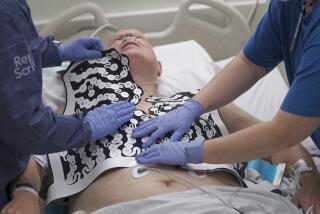Gene Therapy Provides Internal Band-Aid : Medicine: Researchers say the technique is a step toward reducing risk of heart attacks and strokes.
- Share via
SAN ANTONIO — Michigan doctors have succeeded in using genetically altered cells to act as an internal Band-Aid, a technique that eventually might be used to prevent atherosclerotic lesions from worsening, it was reported here Monday.
Although the work so far has been done only in animals, and with genes that do not produce biologically active products, the research represents a leap toward gene therapy to prevent heart attacks and strokes, the president of the American Heart Assn. told science writers.
The Michigan work is generating much excitement among cardiovascular researchers because it “points out to them the potential for broadly moving their field and other fields forward,” Dr. Myron L. Weisfeldt said.
Dr. Elizabeth G. Nabel, assistant professor of medicine at the University of Michigan, reported at the meeting that her research group had used a common cardiovascular technique--balloon angioplasty--to insert genetically engineered cells into the arteries of Yucatan mini-pigs.
The group infected endothelial cells--which line the interior of the blood vessels--that had been taken from the pigs earlier with a retrovirus that had itself been altered with a bacterial gene. Because a retrovirus inserts its own genetic code into infected cells, the enzyme-producing bacterial gene became part of the pig cells’ genetic machinery.
The altered cells were inserted into the pig artery through a balloon catheter. There they established a healing layer of endothelial cells over the atherosclerotic lesion, which is an accumulation of fat-filled cells on the artery wall. The layer successfully produced the bacterial enzyme, showing that a foreign gene could work in this way, Nabel said.
Aware of problems that other proposed gene therapies have had in obtaining results, Nabel was cautiously optimistic. “We have established the feasibility of using endothelial cells as factories for artery repair,” Nabel said.
The endothelial cells eventually might be modified to secrete anti-clotting proteins to prevent blockage of the artery at atherosclerotic plaque sites. Noting that plaques themselves produce substances that promote their own growth, Nabel said the endothelial Band-Aid might also contain genes to block these growth promoters.
Since endothelial cells are in organs throughout the body, she added, these designer cells might even be engineered to produce anti-cancer drugs at tumor sites.
Still, she called such applications “pie in the sky,” and said she did not expect the research to bear clinical fruit for perhaps 20 years.
Part of the reason for that is the extensive safety monitoring that would have to be done before such techniques could be used in humans, she said. Retroviruses would have to be shown unable to cause harmful infection before they could be used in humans. The inserted genes would also need to have only a localized effect, so they would not harm other body systems.
Weisfeldt, however, said he thought that if the technique proves promising, it might be usable early on in people for whom there is no other hope of survival. For instance, heart transplant patients often develop life-threatening atherosclerosis a few years after transplant as a result of the operation.
Endothelial cells have become a prime target for genetic engineers because their location inside the blood vessel ensures that hormones or other biological agents they produce will be distributed throughout the body. They are also easier to work with than bone marrow cells, which had previously been the target of choice.
Geneticists around the country are already experimenting in animals with altered endothelial cells that deliver CD4, a protein that blocks the AIDS virus; a clotting factor to prevent excessive bleeding in hemophilia; adenosine deaminate, which is missing in children with certain genetic disorders of the immune system; and von Willebrand’s factor, which cures another genetic bleeding disorder.
Researchers speculate the technique could also be used to produce tissue plasminogen activator, which would prevent the formation of blood clots that cause strokes and heart attacks, and even insulin for diabetics.
Most researchers agree that several years will elapse before attempts are made at human therapy by genetic engineering. To date, genetically engineered cells have been introduced into only a handful of humans as part of an anti-cancer therapy devised at the National Cancer Institute.
Last May, researchers there used genetic engineering techniques to insert markers into white blood cells that are used in therapy of malignant melanoma, a particularly severe form of skin cancer, to help track the cells through the body. A total of 10 patients are to be treated, and so far no ill effects from the genetically engineered cells have been observed.
REPAIRING INJURED ARTERIES
In miniature pigs, scientists at the University of Michigan used this two-ballon technique to insert replacements for the injured cell layer that normally lines the arteries, but which is damaged in atherosclerosis. Because the inserted cells successfully produced an enzyme that they had been genetically altered to make, the researchers see the angioplasty technique--already used to unblock arteries in humans--as a potential way to both repair injured artery walls and make them produce lesion-inhibiting proteins that would reverse or prevent further atherosclerosis.






